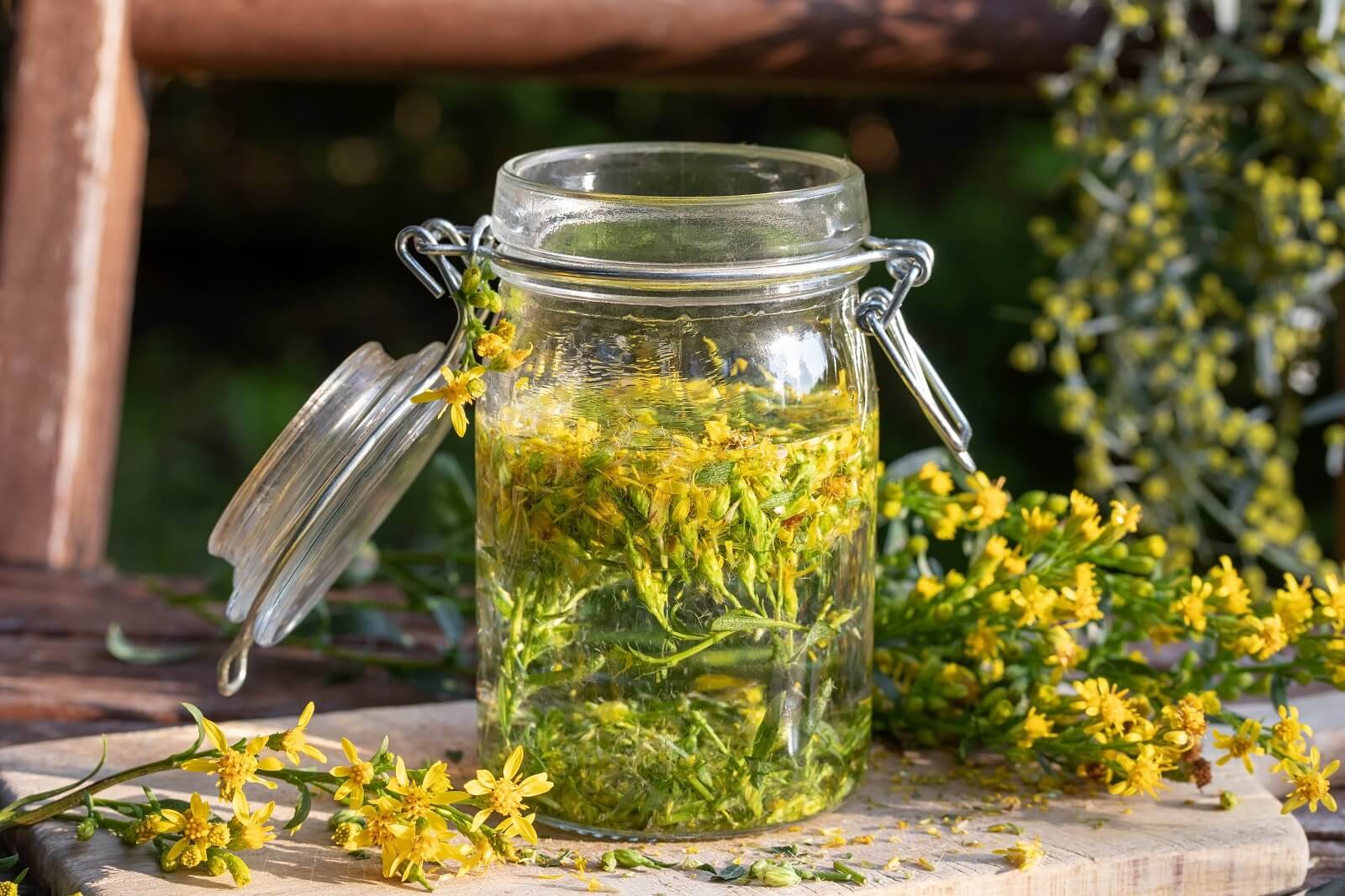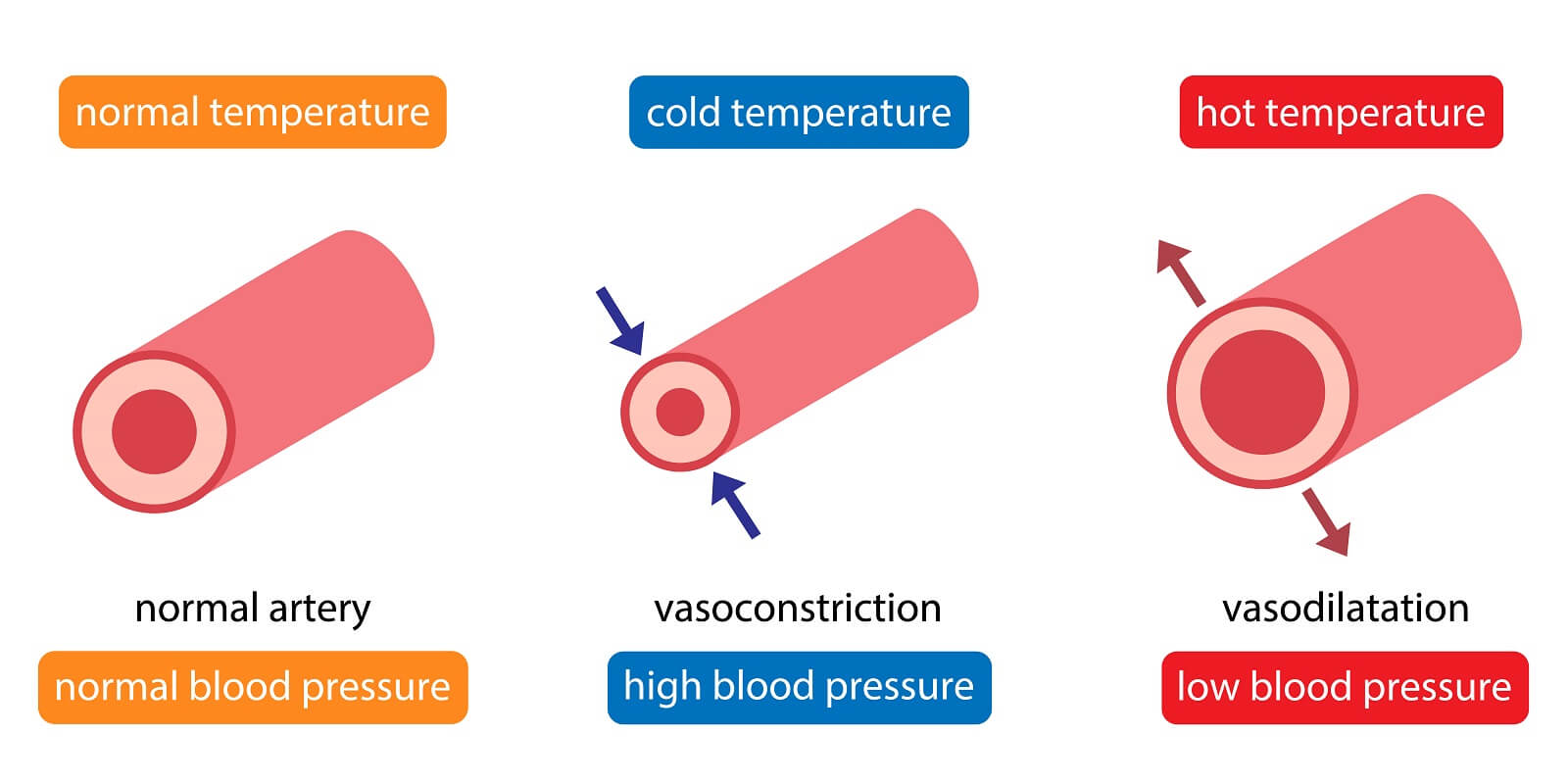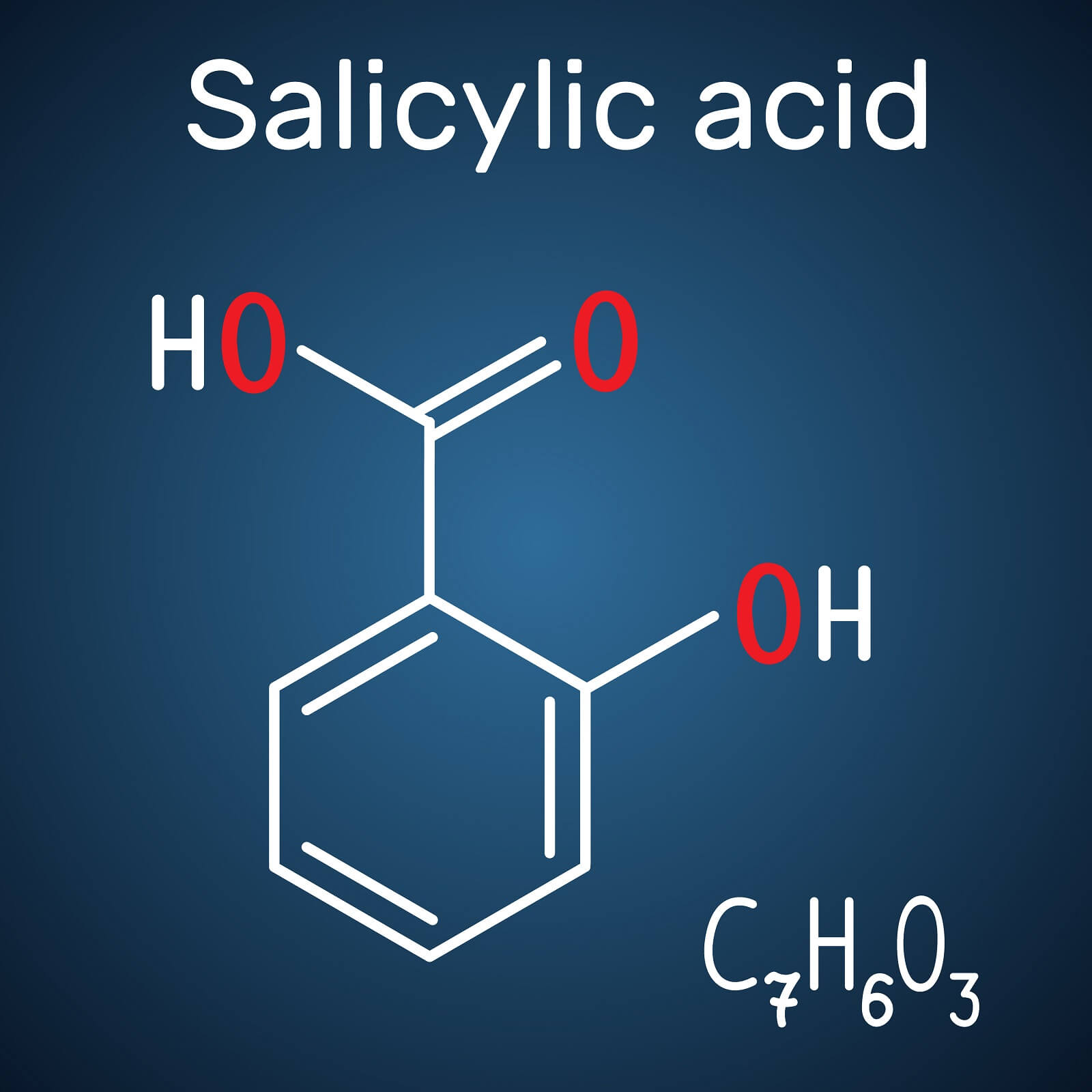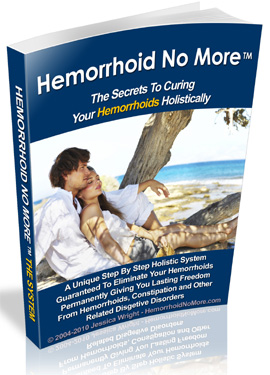
Goldenrod (Solidago spp.) does help heal hemorrhoids; in fact the meaning of the genus name Solidago in latin is “to make whole.”(source 28) Like the name implies, this herb can help restore proper function to your rectal area. Traditional medicine employs decoctions or infusions of the herb for use as an anti-inflammatory or antibacterial.(source 10) For example, European herbalists have worked with this herb for 700 years as a way to prevent and reduce inflammation.(source 6) And, this herb is still effective today!
Goldenrod helps treat hemorrhoids in five primary ways:
- It reduces inflammation
- It acts as a styptic (something that stops blood flow)
- It is a natural astringent
- It can relieve pain
- It is a mild antimicrobial
Goldenrod is used topically in traditional herbal medicine, but you can also take this herb internally to possibly act as a vasoconstrictor for swollen rectal veins. Consider pairing goldenrod with another very popular topical herbal hemorrhoid treatment: witch hazel (Hamamelis virginiana). The simultaneous use of these herbs may be more effective than either one in isolation.
How to use Goldenrod for Hemorrhoids
If I wanted to use this herb for hemorrhoids I would look for a quality salve and try to apply it at night and keep the package directions in mind. I would also try to use another natural topical essential oil treatment, like peppermint oil for example, with the salve. This would help reduce itching and pain while promoting healing.
Another topical option would be to make an infused oil with goldenrod. Try combining this herb with plantain and yarrow for a home remedy that supports wound healing.
For internal use Dr. James Duke, in his book The Green Pharmacy Herbal Handbook,(source 1) gives the following dosage guidelines for goldenrod:
- 1/2 to 1 teaspoon of liquid leaf extract each day
- 6 to 15 grams of the herb dried and chopped in a cup of boiling water
Naturally Treat Hemorrhoids in 48 Hours
Jessica Wright’s unique 5-step, all-natural approach to hemorrhoid treatment delivers permanent relief. Heal hemorrhoids in 48 hours, and eliminate the root cause in 30 to 60 days.
Benefit from Jessica’s 12 years of research; her book is backed by a 60 day, 100% money back guarantee.

Goldenrod is an Effective Astringent & More

According to a 2005 study in Alternative & Complementary Therapies(source 2) the classic herbal treatment for hemorrhoids, witch hazel, is frequently prescribed as a decoction or as an alcohol-preserved decoction for this condition. Witch hazel is well known as a tannin rich, astringent herb. The study also states witch hazel has demonstrated astringent and vasoconstrictive properties in pharmacologic studies. It seems plausible that the astringency of goldenrod may be able to also produce a vasoconstrictive effect.
A 2021 study in Evidence-Based Complementary and Alternative Medicine(source 29) confirms astringents can help constrict blood vessels and halt blood flow. According to this study:
Astringent agents’ actions result in mechanical constriction of small blood vessels and shrinkage of body tissues, thereby stopping blood loss. This enhances the primary phase of hemostasis, where vasoconstriction is the main mechanism at play during the initial response to injury. The effects of plant extracts on protein precipitation have been linked to blood vessel vasoconstriction.
Evidence-Based Complementary and Alternative Medicine (2021)
A 2007 study in Planta Medica(source 3) speculated that astringent herbs can help heal hemorrhoids by plugging up minute leaks and holes in the veins and capillaries thereby promoting vein elasticity and acting as vasoconstrictors in the perianal area.
According to a 2020 study in Biomolecules(source 4) Russian folk medicine utilized European goldenrod (Solidago virgaurea L) as an astringent and for stopping the flow of blood.
A 2016 study in Cancer Research(source 5) describes European goldenrod as having astringent and antiseptic properties.
A 2010 study in the Journal of Basic and Clinical Pharmacy(source 6) describes Canadian goldenrod (Solidago canadensis) as having blossoms that are astringent and pain relieving. Infusions of the dried root powder are antiseptic. Additionally, this herb has been used by European herbalists for 700 years as a way to prevent and reduce inflammation.
A 2011 study in the Journal of Pharmacy Research(source 7) discussed Canadian goldenrod and stated the blossoms are astringent, pain relieving, and a fever reliever.
Samuel Bart’s Digestive Health Solution
Samuel Bart has always been passionate about plants and their ability to keep us healthy. He has put together some of the best natural ways that could help anyone support a healthy digestive system.
Samuel perfected an easy, yet powerful formula, which consists of amazing ingredients. Bart’s supplement is backed by a ironclad 60-day, money back guarantee.

Goldenrod Helps Wound Healing
The genus name for goldenrod is Solidago is derived from the Latin word “solida,” meaning “whole” and “ago” meaning “to make.” Thus the genus simply means “to make whole.”(source 28) This herb does appear to be able to assist with wound healing. This may be primarily due to the anti-inflammatory effect. Let’s take a look at research on this topic.
A 2021 study in Biomedical Journal(source 8) investigated how sweet goldenrod (Solidago chilensis) improved repair of burn wounds in diabetic rats. The study used the fresh leaves of the plant to create an extract using water and alcohol.
The study found that the herbal extract was effective at shortening the length of the inflammatory phase of wound healing.
The inflammatory phase is the second step in the wound healing processes; following hemostasis (the stopping of the wound from bleeding / blood vessel leakage). The inflammatory phase starts within the first 24 hours of wound infliction and can last up to 2 weeks in normal wounds; chronic wounds can extend this timeframe much longer. The characteristic signs of inflammation during this phase are swelling, redness, heat, and pain.(source 9)
The study concluded that sweet goldenrod extract improved the repair of burn wounds in rats as it reduced the inflammatory infiltrate and favored the collagen organization presenting similar effects in the burn repair of the diabetics.
A 2020 study in Biomolecules(source 10) discusses the traditional use by cultures of European goldenrod. The study states that traditionally, this herb has been used for its healing and antiseptic properties. Traditional medicine has also employed decoctions or infusions of the herb for use as an anti-inflammatory or antibacterial.
Dr. John Herzog (MD)
Dr. John Herzog, a "survival surgeon" from Maine explains what home remedies work best in a crisis situation.
This may be important in the event you require first-aid or are in an emergency situation without easy access to a hospital. Dr. John Herzog has assembled a large collection of home remedies for such scenarios.

Goldenrod Reduces Inflammation

Goldenrod has been shown to be an effective reducer of inflammation. Possibly the main reason for this ability is due to the presence of salicylates (the active ingredient in aspirin is a synthetic salicylate). So let’s take a look at some of the research verifying this.
A 2021 study in Scientia Pharmaceutica(source 11) looked at how European goldenrod affected inflammation by measuring paw swelling in rats. The study used a dry extract of the herb for their research. The study found that European goldenrod was able to reduce inflammation, but was a little less effective at doing this than diclofenac (a drug used to reduce swelling and pain; common brand names: Cambia, Flector, Zipsor).
A 1992 study in Arzneimittel-Forschung(source 12) also found that European goldenrod was able to reduce inflammation in carrageenan (carrageenan is sulfated galactans [sulfated galactans are polysaccharides with a lot of negative ions found in marine organisms] that are mostly isolated from marine red algae(source 13)) induced swelling in rat paws.
The study also tested combinations of European goldenrod, European aspen (Populus tremula), and European ash (Fraxinus excelsior). The combinations of these herbs showed anti-inflammatory ability respectively comparable to the tested doses of diclofenac.
This seems to show us that using more than one anti-inflammatory herb together may bring about an even better solution to swollen hemorrhoids.
If you want to try using multiple anti-inflammatory herbs, make sure to check if the herb contains salicylates. It is important to be aware you can overdose on salicylates if you are not careful. And, salicylate toxicity can be a medical emergency.(source 14)
I would estimate a synthetic salicylate drug like aspirin is more liable to induce toxicity than a common pain relieving herb like willow bark. Yet, it is important to be aware of the danger and avoid overdoses.
You may be familiar with the connection between willow bark and aspirin. The major active phytochemical in willow bark is salicin. Salicin was the original source of aspirin.(source 24) Yet, aspirin is actually the synthetic compound acetylsalicylic acid; which is chemically similar to salicin. In 1899 acetylsalicylic acid was registered and marketed by Bayer under the trade name aspirin.(source 23)
The willow species contain only a low amount of the prodrug (a compound with little or no pharmacological activity itself, but is metabolized by the body into a pharmacologically active compound) salicin. Salicin, after intake, is then metabolized by the intestinal flora to saligenin; which is then further metabolized by the liver to salicylic acid.(source 21)(source 22)
According to chapter 18 of the 2015 book Phytotherapies,(source 15) natural medicine was the only way to treat inflammation and reduce pain before the era of chemotherapy. The book list the following herbs, all of which contain salicylates, as some of the most popular treatments in this regard:
- Willows (Salix spp.) – The active ingredient of the bark is salicylic acid.(source 16)
- Goldenrod – Contains salicylic acids.(source 4)
- Wintergreen (Gaultheria procumbens) – Methyl salicylate is a major component of wintergreen oil; it relieves pain and is utilized by many over-the-counter topical use products. Please be aware that methyl salicylate, if ingested, is very poisonous.(source 17)
- Meadowsweet (Filipendula ulmaria) – Contains the salicylates: salicylic acid, methyl salicylate, salicylaldehyde, salicyl alcohol, and their glycosides.(source 18) The high content of salicylic acid and its derivatives is also a feature of meadowsweet.(source 19)
- Aspen trees (various Populus spp.) – Aspens belong to the taxonomic Salicaceae (willow) family, and like other members of this family, the ivory bark contains salicylic acid.(source 20)
It is good to remember that anti-inflammatory herbs may contain pharmacologically significant levels of salicylates. Therefore, don’t forget this helpful reminder to be proactive with safe dosage to avoid an overdose on salicylates!
Claire Goodall’s Amazing Guide
Clair Goodall is a bee-obsessed, natural medicine convert from Minnesota (USA). And, she does keep bees!
Clair has created 350+ page book documenting how to replace the toxic products and medications in your home with healthier, all-natural alternatives.

The Antimicrobial Ability of Goldenrod
Goldenrod does appear to be able to reduce virulence factors of Candida albicans (the fungus which is the major cause of yeast infections) and appears to have a weak antibacterial effect on some bacteria. Therefore one major antimicrobial advantage the topical use of this herb can convey is helping to prevent anal yeast infections. But, overall, this herb does not appear to be too impressive in its antimicrobial ability.
According to a 2020 study in the Moscow University Chemistry Bulletin(source 25) goldenrod does have some antibacterial efficacy. The researchers used an alcohol and water extraction Canadian goldenrod using 70% ethanol (which is drinking alcohol) and raw plant material in a 1:5 ratio.
The zone of inhibition (ZOI) was used to determine antibacterial ability; which shows the area around a sample of the extract in which bacteria will not grow. The study found the extract had a mild antimicrobial effect against Bacillus cereus (ZOI = 14.5mm) and a low antimicrobial effect against Staphylococcus aureus (S. aureus) (ZOI = 11.0mm). No effect was seen against Escherichia coli (E. coli), Serratia marcescens, or Streptococcus pyogenes.
A 2014 study in Phyton(source 26) looked at the antibacterial and antifungal ability of European goldenrod, Canadian goldenrod, and giant goldenrod (Solidago gigantea Aiton). The researchers prepared extracts separately from the roots and leaves using either water, ethanol, or other organic solvents.
The bacteria tested were: Bacillus subtilis (B. subtilis), S. aureus, and E. coli. The fungi tested were: Armillaria mellea, Fusarium spp., and Phytophthora infestans.
The study found the water extract of the three goldenrod species created no ZOI against any of the tested bacteria. S. virgaurea, with any extract, did not produce a ZOI against any tested bacteria. Ethanol extracts produced the following ZOIs:
- Ethanol S. canadensis root: for B. subtilis = approx. 1.0mm
- Ethanol S. gigantea leaves: for B. subtilis = approx. 4.3mm
- Ethanol S. gigantea root: for B. subtilis = approx. 5.7mm
- Ethanol S. gigantea root: for S. aureus = 2.0mm
Concerning the tests on the fungi, none of the water extracts were able to produce an antifungal effect. Other extracts were only able to produce a weak effect. Yet, the study does mention other research has shown water extracts have an inhibitory effect against yeast isolates.
A 2012 study in the Journal of Medical Microbiology(source 27) determined how a water extract of European goldenrod would affect various microorganisms. The water extract did not inhibit the growth of four strains of Candida albicans, S. aureus, E. coli, Streptococcus mutans, Pseudomonas aeruginosa, Streptococcus salivarius or Enterococcus faecalis.
Yet the study did find that the extract reduced C. albicans hyphal growth transition (C. albicans can grow long tendrils that are called hyphae) and inhibited biofilm formation (C. albicans can create a thick type of sludge to cover itself known as biofilm; this can improve its resistance to antifungal drugs).
Heal Hemorrhoids Naturally in 48 Hours

If you have tried "everything" to treat hemorrhoids, including surgery, but it didn’t work—your’re not alone. Jessica Wright experienced this same hardship due to hemorrhoids. But, with extensive research and understanding of natural medicine, she developed a solution to permanently end her hemorrhoids.
Jessica Wright wrote an entire book detailing exactly how to replicate her success. Also, it appears "Jessica Wright" is probably a pen name for a woman—and author—named Linda Allen. Linda suffered from recurrent yeast infections as well, maybe at the same time as she had hemorrhoids. She turned to natural medicine for answers when medical doctors and their solutions could not help.
Jessica’s story is one of severe and chronic hemorrhoids. It involves routine doctor’s visits, prescription medications / creams, significant suffering from hemorrhoids, and even a two hour hemorrhoids surgery (stapled hemorrhoidopexy). Yet, 12 years of these treatments didn’t resolve Jessica’s hemorrhoids.
Despite these setbacks, Jessica didn’t give up; instead, she turned to natural medicine and diligent research. Skipping to the end of Jessica’s story, she would develop a natural method to treat hemorrhoids that worked brilliantly.
After Jessica put together her treatment protocol and used it, she found her hemorrhoids completely disappeared. And, they stayed gone. Something her doctor was not able to do. Yet, all it took was the right natural therapeutic approach.
Jessica also gave her treatment approach to others; and, they experienced the same exceptional results. Typically, Jessica’s system provides dramatic relief of hemorrhoids in just 48 hours. And, the root cause of hemorrhoids is fixed within 30 to 60 days.
A company selling hemorrhoid symptom products does not want their customer base diminished. Consequently, unpatentable natural medicine does not get much attention or publicity.
So, how can you know if Jessica Wright’s claims are legitimate and not a scam? That is a great question. Here are 3 important reasons why Jessica’s book is legitimate:
- It is published by a large U.S. based company (Located in Idaho) known as ClickBank. ClickBank handles all the sales and refunds of many products like Jessica’s. They do business in many countries; and, have been in business for many years.
- ClickBank provides a 60 day, 100% money back guarantee on all their products, Jessica’s book included.
- If you are not satisfied with Jessica’s book you can simply contact ClickBank (they make it very easy) for a full refund.
Jessica’s story is more in-depth than this concise overview. And, there are additional bonuses Jessica provides with her book. If you’d like to find out more about Jessica’s personal story or her hemorrhoid treatment; you can learn more at Jessica Wright’s website.
About the Author
Nick Gross is a natural medicine enthusiast who has been researching and writing about natural medicine since 2008. Nick is primarily a web developer, but also researches and authors written and video content about natural health. Nick has a bachelor’s degree in Management Information Systems from the University of Northern Iowa.
More on Nick GrossImportant Disclosures & Disclaimers
It is important to use the information you find on Herbsey.com in the right way. Also for legal reasons, these disclaimers and disclosures are necessary. For further information about each, feel free to click the link provided to the page on this website that provides more information.
Medical Disclaimer
The information on this website is not a prescription for anyone. This information is for informational or educational purposes only, and is not a substitute for professional medical advice or consultations with healthcare professionals.
Advertisement Disclosure
Some of the links provided on this article and website are affiliate links. If you purchase a product after clicking on these links, Herbsey.com will earn a commission. Herbsey.com promotes various products through advertisement and text links. For more information: Our Advertisements.








